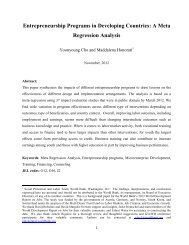STATE OF THE FIELD IN YOUTH ECONOMIC OPPORTUNITIES
STATE OF THE FIELD IN YOUTH ECONOMIC OPPORTUNITIES
STATE OF THE FIELD IN YOUTH ECONOMIC OPPORTUNITIES
You also want an ePaper? Increase the reach of your titles
YUMPU automatically turns print PDFs into web optimized ePapers that Google loves.
Table of Contents<br />
Chapter 1 Chapter 2 Chapter 3 Chapter 4 Chapter 5 Chapter 6 Chapter 7 Chapter 8<br />
Chapter 9<br />
Chapter 10 Chapter 11 Chapter 12 Chapter 13 Chapter 14 Chapter 15 Annexes<br />
2012 State of the Field in Youth Economic Opportunities<br />
Chapter 7: Asset-Based Approaches:<br />
Building and Protecting Assets of AGYW<br />
7.3 Locate the Dependency Burden, Especially the Cost of Children More<br />
Equitably Between Males and Females<br />
A high proportion of the world’s women support themselves and their children. Shelly Clark of the Population<br />
Council undertook research supported by the Population Council and Nike Foundation to revisit womenheaded<br />
households or single motherhood. She found in four African countries a range of between 30-70 percent<br />
of girls and women will be single mothers at some point in their reproductive lives. 43 As age expectancy rises,<br />
the dependency burden increases because women must support aging populations and children. Migration<br />
also complicates the situation for AGYW as male migration leaves many women dependent on remittance<br />
income. Even as girls find success in the earlier stages of their life, by attending school, earning income, and<br />
delaying fertility, the unbalanced distribution of time and income that women spend on children may zero<br />
out other gains. Bruce noted that of all the factors robbing females of their share of economic vocation their<br />
disproportionate time and financial responsibility for older and young dependents is the “mother of all factors”.<br />
Failure to change this dynamic will contribute not only to the impoverishment of AGYW but drive intergenerational<br />
poverty. Increasing the father’s share of time and financial costs for children will lead to more<br />
sustainable gains for females and help to reduce household poverty.<br />
7.3.1 Bright Ideas: The Population Council on Redistributing the<br />
Dependency Burden<br />
At the 2011 GYEOC, Bruce offered some modest<br />
proposals to reshape the long-term dependency<br />
burden on females. YEO programs could integrate<br />
the following into their programs to create a more<br />
equitable situation for AGYW:<br />
• Establish child savings accounts at birth along with<br />
unique personal number<br />
• Register births noting fatherhood<br />
• Provide incentives for both parents to attend the<br />
registration of a child at school (both primary and<br />
secondary) – and acknowledge responsibility for<br />
school fees and other support<br />
• Initiate “attached” remittance policies and<br />
incentivize investment in children by absent parent<br />
• Institute Civil Debt so that unpaid child support is<br />
viewed the same as any other debt<br />
• Establish community based childcare so parents can<br />
help each other with childcare<br />
These policies will require some complicity from<br />
government authorities. This could be just as<br />
important as, or more so than, special training or<br />
livelihoods initiatives. 44<br />
• Prioritize property rights for custodial parent<br />
44 Judith Bruce. “The Unique Reasons Girls (and Later Women) are<br />
Poor and What We Can Do About It.” Presentation for Making<br />
Cents International’s 2011 Global Youth Economic Opportunities<br />
Conference. September 8, 2011.<br />
43 Single Motherhood, Poverty, and Child Mortality in Sub-Saharan Africa: A Life Course Perspective. Population Association of America Annual Meeting,<br />
Washington, D.C., March 31, 2011<br />
86

















